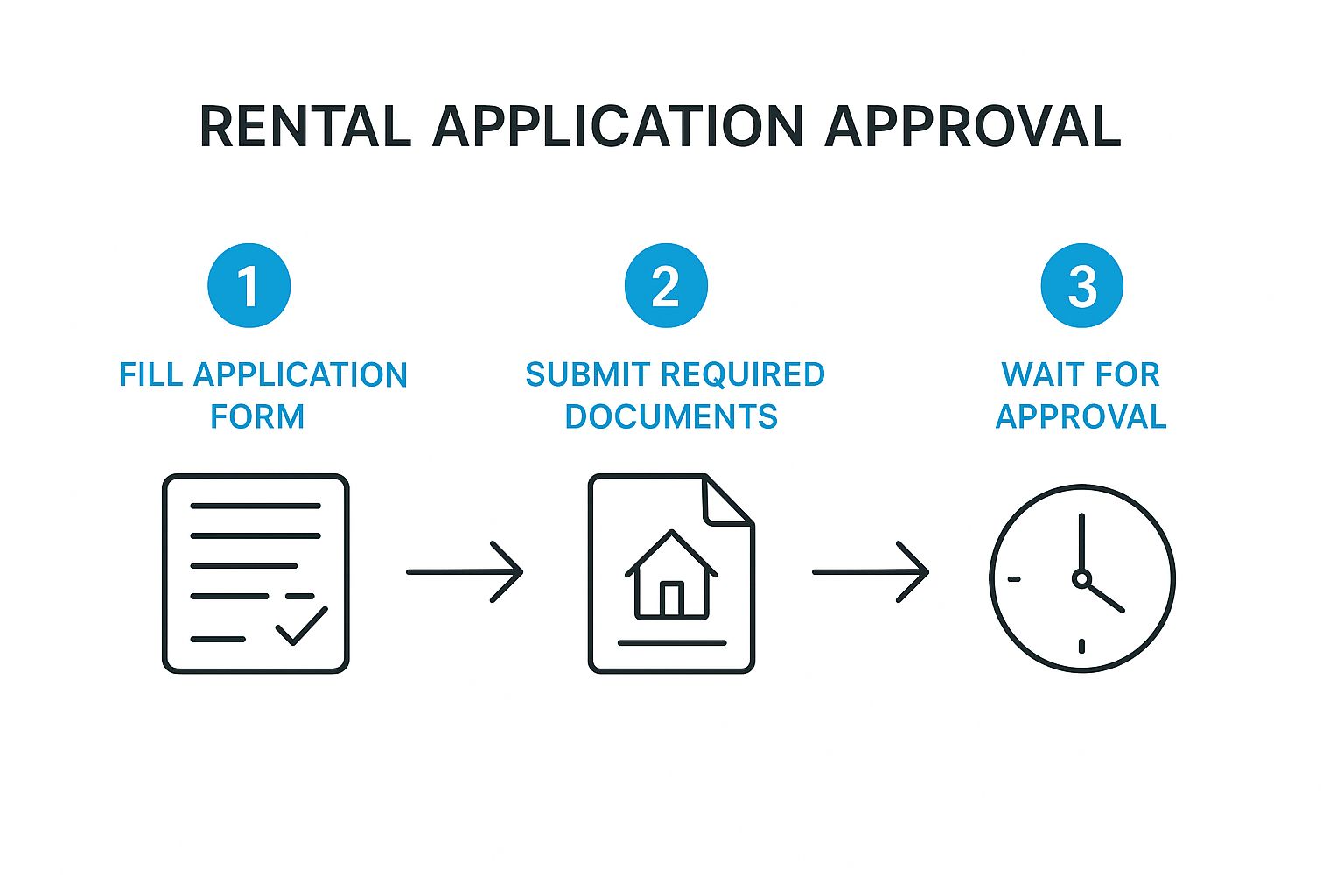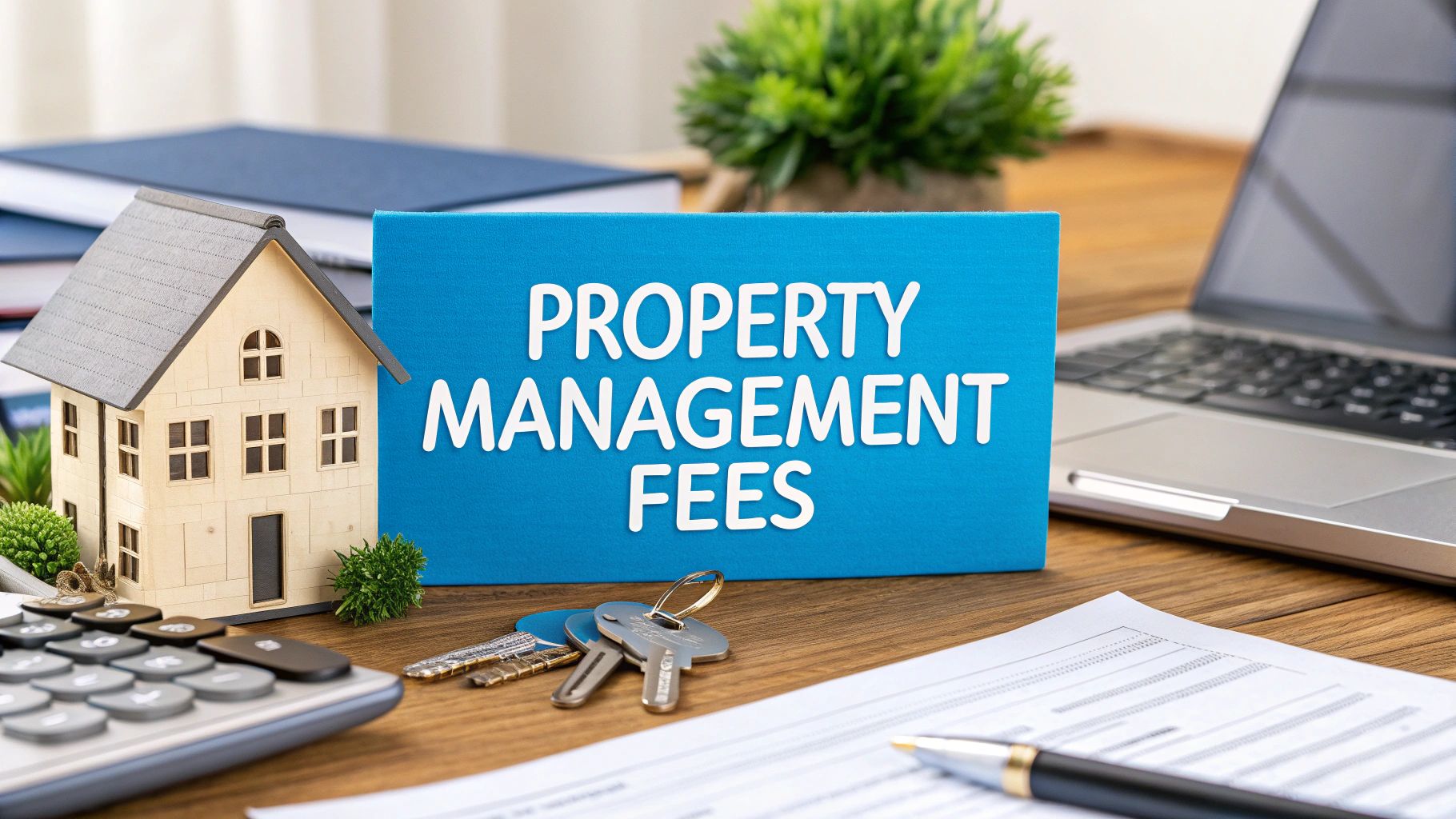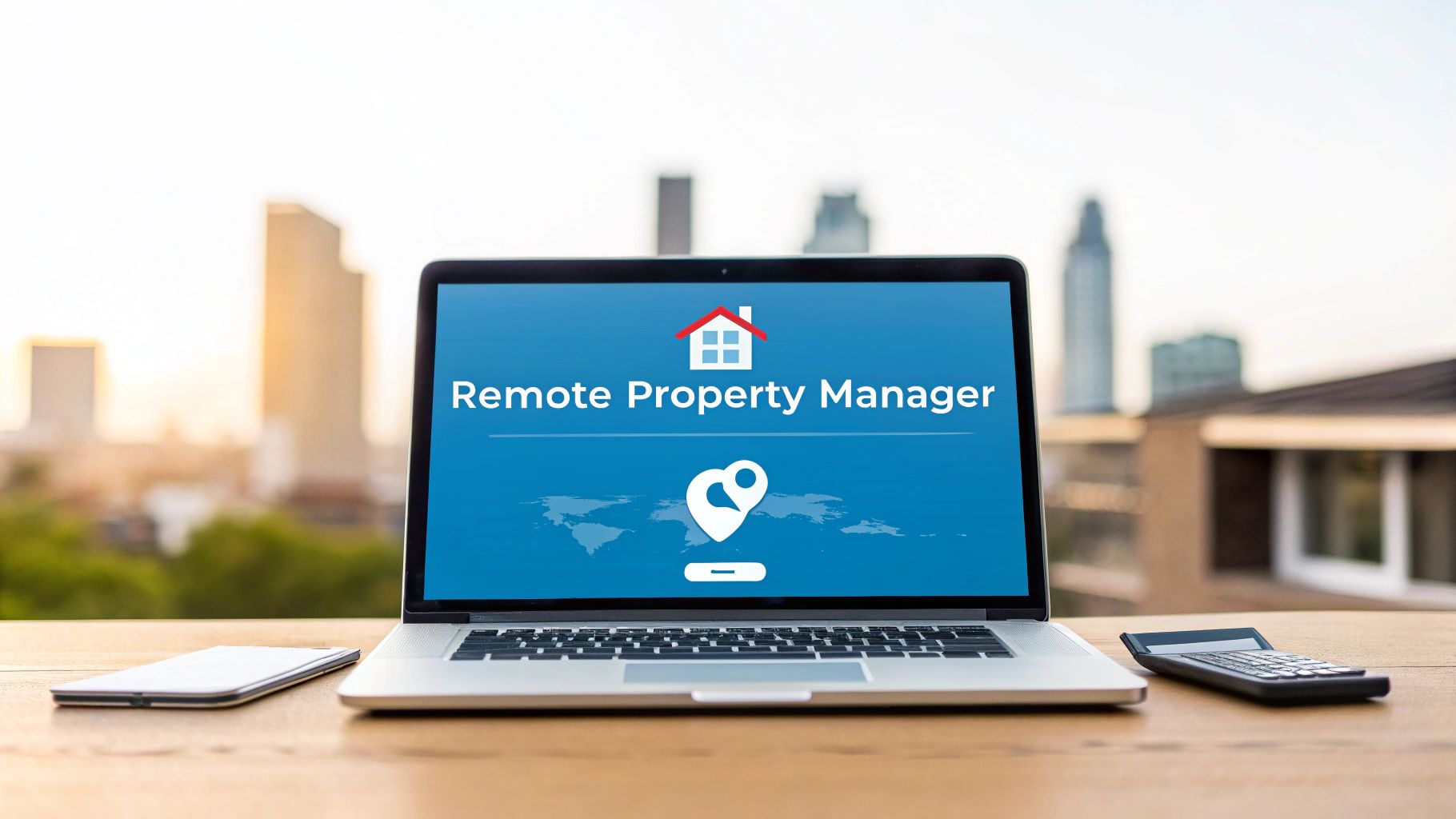What Actually Matters to Landlords (Hint: It's Not What You Think)
So many renters get hung up on having a flawless credit score, but the truth about rental application approval is a lot more complex. At their core, landlords and property managers are in the risk management business. Their main goal isn’t just to fill a unit; it's to find someone who will be the path of least resistance—a tenant who pays on time, takes care of the property, and doesn't cause drama. This is less about rewarding past financial perfection and more about predicting your future behavior as a renter.
Think of your application less like a test you pass or fail and more like a business proposal. You're offering a deal: consistent income and responsible care of the property in exchange for a place to live. A landlord’s decision often boils down to one simple question: "Is this person going to make my life easier or harder?" An applicant with a so-so credit score but a fantastic rental history and stable income often looks like a safer bet than someone with an 800 score who has jumped from place to place every year. The first applicant shows stability, while the second raises red flags about their long-term reliability.
The Psychology of a "Yes"
Beyond the raw numbers, there are big psychological factors at play. Your entire interaction, from the first email you send to the documents you submit, shapes the landlord's perception of you. A complete, organized, and professional-looking application sends a clear message: you're responsible and pay attention to detail. On the flip side, a messy or incomplete application hints that you might be a careless tenant.
Imagine this scenario: two applicants have nearly identical financial backgrounds. Applicant A turns in a perfectly organized package, complete with a short, polite cover letter explaining why they love the property. Applicant B emails a jumble of blurry photos of their documents. Who gets the callback? Applicant A, of course. They've already shown respect for the landlord's time and process, building a little trust before a lease is even on the table.
Understanding Broader Market Forces
It’s also smart to understand what's happening in the wider rental market. The economy and changing lifestyle choices are making things more dynamic. For instance, 49% of renters in the United States are under 30, and a massive 77% of Americans now prefer renting to buying a home. This means property managers are seeing a flood of younger, career-focused renters. As a result, they're adjusting what they look for, often giving more weight to steady employment and glowing references than a decades-long credit history.
You can learn more about these shifts in this detailed renting statistics report. Knowing this helps you tailor your application to show what modern landlords value most: a reliable, long-term partner in a very competitive market.
Crafting an Application That Stands Out From the Stack
Think of your rental application as more than just a form—it's your personal marketing brochure. In a competitive market, a polished, complete, and thoughtful submission can dramatically improve your chances of getting that rental application approval. It's your first, best opportunity to tell a compelling story of stability and responsibility, making you the obvious choice for any property manager.
This process visualization breaks down the core journey from submission to approval.

As you can see, the path is pretty straightforward, but the quality of what you provide at each stage is what truly matters. Getting organized ahead of time is the secret to moving smoothly from one step to the next without any friction.
Assembling a Narrative of Reliability
To build a strong case, it's essential to have your paperwork in order. The table below outlines the documents you'll need, separating the must-haves from the nice-to-haves that can give you a real edge.
Having these documents ready to go shows you're serious and organized. It tells the property manager you respect their time and are prepared to be a responsible tenant.
When you gather your financial documents, don't just dump them into an email. Organize everything logically, maybe in a single PDF file with clear labels. This small act of organization immediately signals that you’re a detail-oriented person. Think of your documents as chapters in your story of financial stability. Your pay stubs prove current income, while past W-2s or tax returns can demonstrate a consistent earnings history, even if you’ve switched jobs.
If you have employment gaps or are a freelancer with variable income, don’t leave the property manager guessing. Address these situations head-on.
- For Gaps: A brief, positive explanation in a cover letter can work wonders. For instance, "I took six months off between roles for professional development and travel, and I'm now three months into my new position at XYZ Company."
- For Freelancers: Provide more than just the last two bank statements. Show 6-12 months of consistent deposits, offer tax returns from the last two years, and include letters from long-term clients if possible. This builds a picture of reliable, diversified income.
Going the Extra Mile With Supporting Documents
The standard application asks for the basics, but providing strategic extras can set you apart. Consider including a short, professional cover letter that acts as a personal introduction. This is your chance to connect on a human level. Mention something specific you admire about the property and briefly state why you would be an excellent tenant.
Additionally, written references from previous landlords can be incredibly powerful. A glowing letter confirming you paid rent on time and left your previous unit in great shape is often more persuasive than a credit score alone. In fact, many landlords consider past rental behavior a top predictor of future performance. Just as a landlord documents the property's condition, your references document your reliability as a tenant. For more on why documentation is critical from the landlord's perspective, you can learn about the importance of property condition reports.
By providing these extra details, you’re not just filling out a form—you’re making a compelling case that you're the best candidate for the home.
Decoding Modern Tenant Screening Systems

When you hit "submit" on a rental application, it doesn't just land in a simple inbox. It kicks off a detailed process where technology and human insight work together to find the best fit. Knowing how this system works from the inside gives you a major advantage in getting your application to the top of the pile.
The business of tenant screening is bigger than you might think. It’s a serious industry that was valued at USD 3.67 billion in 2023 and is expected to more than double to USD 7.10 billion by 2032. This massive investment, as detailed in this global tenant screening market analysis, shows just how much property managers rely on these tools to minimize risks and make sound decisions.
The Automated First Pass
Your application's first stop is almost always an automated screening platform. This software is the initial gatekeeper, programmed to scan for specific criteria set by the property manager. It’s incredibly fast and efficient, but it doesn't see the whole picture—it only sees the data you provide.
Here are some common red flags that can get your application automatically filtered out:
- Income that doesn't meet the minimum: Most landlords look for an income that's at least 3x the monthly rent.
- A credit score below the required number: A specific score is often set as a baseline.
- History of evictions or collections: Past issues with landlords are a major concern.
- An incomplete application: Missing information or blanks can lead to an instant rejection.
This is why double-checking every detail is so important. A simple typo in your income field or a forgotten previous address could cause the system to reject your application before a person even lays eyes on it.
The Human Element: Final Review
If you make it past the automated check, your application lands on the desk of a real person. This is where a property manager or leasing agent digs deeper, looking at the context behind the numbers. They have the ability to see nuances that software can't.
For example, they might see a lower credit score but notice it was caused by a one-time medical emergency, not a pattern of financial irresponsibility. They’ll also be the ones calling your previous landlords to confirm you were a great tenant and checking your employment history for stability. This is your chance to shine. A thoughtful cover letter or glowing references can give the property manager a reason to choose you.
To get a better sense of what goes on during this manual review, our guide on how property managers screen for ideal tenants offers some great insights. Ultimately, your goal is to make it past the software and win over the human.
Turning Application Challenges Into Competitive Advantages
Perfect credit and a flawless job history are great, but let's be real—they aren't the only way to lock down your dream rental. Most renters have some real-world bumps in their history, whether it's a credit score that’s seen better days, freelance income, or even a past eviction. The trick isn't to hide these things but to tackle them head-on with a smart strategy that builds trust.
Navigating Credit and Income Hurdles
Let’s start with the big one: credit. A low score doesn't have to sink your application. Your first move should be to pull your own credit report to see exactly what landlords will see. Sometimes, a score is dragged down by simple mistakes or old accounts. Don't let someone else's error cost you a home; learn how to start disputing credit report errors and clean up your financial profile.
If the low score is accurate, get ready to explain it. A short, honest note in your cover letter can work wonders. For example, saying "My credit was impacted by a medical issue in 2022, but I have since been on-time with all payments for 24 months" turns a red flag into a story of recovery and responsibility.
For freelancers or anyone with non-traditional income, the goal is to prove you're a stable bet. A couple of recent pay stubs just won't do the job. Instead, you need to build a solid financial portfolio that tells a complete story.
- Gather 6-12 months of bank statements to show a steady cash flow.
- Include your last two years of tax returns to demonstrate a history of earnings.
- Provide letters of intent or contracts from clients to prove you have income lined up for the future.
The Power of Proactive Solutions
When it comes to past issues, transparency is your best friend. A past eviction is a serious hurdle, but it's not always insurmountable. Acknowledge it, briefly explain what happened, and, most importantly, show what’s different now. This could mean showing proof of a stable job, providing glowing references from current employers, or even offering a larger security deposit (where local laws allow). Your goal is to show you’ve learned and grown.
Offering a guarantor or co-signer is another powerful move. This is someone who agrees to cover the rent if you can't, giving the landlord an extra layer of financial security and making your application much more appealing.
Landlords are also increasingly worried about application fraud. In just six months during 2020, the number of fraudulent applications seen by property managers in the U.S. shot up from 15% to 29%. You can dig deeper into these trends in tenant fraud statistics to understand their perspective. By providing clear, verifiable documents and being upfront, you instantly set yourself apart as a trustworthy applicant. After all, a landlord’s main objective is finding a reliable tenant, which is a crucial part of getting a property ready for occupancy.
Speed Without Sacrifice: Fast-Track Your Approval Process

In a competitive rental market, speed is your biggest advantage. The time between finding a great rental and getting an approval email can often be just a few hours. Winning that race isn't about being careless; it’s about being so organized that you can fire off a flawless application the moment a new listing goes live.
Since most landlords and property managers review applications on a first-come, first-served basis, being first in line with a complete, professional package puts you way ahead of the pack. While a typical approval timeline is between 24 to 72 hours, your preparation can easily place you at the front of that queue.
Prepare Your Application "Go-Bag"
Think of your essential rental documents as a digital "go-bag." The goal is to have everything scanned, organized, and ready to deploy from anywhere. I recommend saving all your documents as high-quality scans in a single, clearly labeled folder using a cloud service like Google Drive or Dropbox.
Here’s a checklist for your go-bag:
- Photo ID: A crystal-clear scan of your government-issued ID (driver’s license, passport, etc.).
- Proof of Income: Your last three pay stubs and your two most recent bank statements. This demonstrates financial stability.
- Customizable Cover Letter: A friendly, professional template that you can quickly personalize for each specific property.
- Reference Letters: Pre-written letters from previous landlords, employers, or colleagues speak volumes about your reliability.
With this system in place, you’re not scrambling to find a pay stub or begging a former landlord for a last-minute reference. When you see a property you love, you just tweak your cover letter, fill out the form, and attach your pre-packaged file. This simple habit can transform your application time from a stressful hour-long project into a five-minute task.
To give you a clearer picture of how processing times can vary, here’s a look at what to expect across different types of properties.
This table shows that while large complexes are often faster due to their streamlined systems, your preparedness is the one factor you can control to accelerate approval, no matter the property type.
The Art of the Follow-Up
Hitting "submit" is a great first step, but it's not the end of the process. A polite, well-timed follow-up email about 24-48 hours after you apply can make a significant difference. It’s not about being pushy; it’s about showing genuine interest and making the landlord’s job easier.
A quick note is all it takes. Try something like this:
"Hi [Landlord or Property Manager Name],
I'm writing to confirm that you received my application for the property at [Property Address]. I'm very excited about the opportunity and am available to answer any questions you might have.
Thank you for your time and consideration."
This simple message reinforces your enthusiasm and shows you’re a proactive communicator—a trait every landlord values in a tenant. This small, professional gesture keeps your application at the top of the pile and the top of their mind.
Strategic Application Targeting for Maximum Success
Applying to a dozen random listings is a recipe for frustration, not a new apartment. A much better approach is to pinpoint properties where your rental application approval is most likely. This isn't about tricking the system; it's about understanding what landlords are looking for and matching your strengths to the right opportunities.
Decode the Listing for Hidden Clues
Every rental ad is filled with hints about the landlord's priorities. If you learn to read between the lines, you can figure out if you’re a good match before you spend a dime on an application fee.
For example, a listing from a large property management company that promotes its online portal and automated payments is sending a clear signal. They want a tech-savvy tenant who follows the rules. Their approval process is probably inflexible, with a heavy focus on hitting specific credit and income numbers. On the other hand, a private owner listing a single-family home who mentions a "quiet neighborhood" and prefers a "long-term tenant" is likely looking for stability and a good personal fit, and might be more flexible on a perfect credit score. A personal cover letter would go a long way in this scenario.
Matching Your Profile to the Property Type
Different types of properties attract different kinds of landlords. A sleek high-rise in the city center will almost certainly demand high income and flawless credit. What about an in-law suite attached to a family's home? The owner is probably more worried about finding a quiet, respectful person who will be a good neighbor. Knowing this helps you focus your energy where it has the best chance of paying off.
Take a look at a standard rental agreement. This is the document that makes the landlord-tenant relationship official.
Getting familiar with the terms in a lease helps you understand what a landlord is really looking for in their ideal applicant.
Develop a Sustainable Application Strategy
Juggling multiple applications can get messy fast, costing you time and money. I recommend setting up a simple tracking system—a basic spreadsheet or a tool like Trello works great—to keep your top choices organized.
Here’s a practical way to manage it:
- Tier Your Listings: Sort properties into three groups: "Top Choice," "Good Fit," and "Backup." This helps you prioritize.
- Focus Your Efforts: Send your absolute best, most polished application to your "Top Choice" properties first. Then, wait for a response before you send a flood of applications to your "Backup" list.
- Tailor Your Approach: For each "Top Choice," take a minute to customize your cover letter. Mentioning a specific feature you love about the property shows you’ve done your homework and are genuinely interested.
This targeted method saves your energy and application fees, making your rental search less stressful and more likely to end in success.
Your Complete Action Plan for Rental Application Success
Alright, let's bring this all together. Getting your rental application approved isn't about crossing your fingers and hoping for the best. It's about having a solid, repeatable game plan that shows landlords you're the ideal tenant from the moment they see your name. Think of this as your final pre-flight check before you start your search for the perfect place.
Your High-Impact Preparation Checklist
Success starts long before you even find a listing you love. Being prepared means you can act fast when the right property pops up. Get these items organized now, and you’ll be able to fire off a complete, impressive application in just a few minutes.
- Create a Financial Portfolio: Combine your last three pay stubs, two months of bank statements, and your two most recent W-2s or tax returns into a single, easy-to-send PDF. This makes you look organized and serious.
- Compile a Reference Sheet: List the contact information for your last two landlords and your current employer. Crucially, give them a quick call or text to let them know a property manager might be reaching out. A prepared reference is a good reference.
- Draft a Personal Cover Letter Template: Write a short, professional letter that introduces you and what you're looking for. Keep it saved so you can quickly customize it with a few details about each specific property you apply for.
Reading the Signs of Success
After you hit "submit," the waiting game begins, and it can be a little nerve-wracking. But there are often subtle clues that things are going your way. If a property manager follows up to ask about a specific move-in date, requests one more document, or starts talking about lease terms, you've likely made it to the final round.
You'll notice their communication might shift from formal to more friendly as they start picturing you in the property. The clearest sign of all? A request to review the lease agreement. That’s your cue to celebrate—you're in! And for anyone moving into their first rental, our friends at Endless Storage put together an awesome First Apartment Essentials Checklist to help you get started.
By consistently using these strategies—thorough preparation, targeting the right properties, and maintaining clear communication—you can turn your rental search from a stressful gamble into a predictable journey to your next home.
Ready to take the next step in optimizing your entire leasing operation? Discover how Showdigs uses intelligent automation to fill vacancies faster and reduce administrative burdens. Schedule your personalized demo today.







